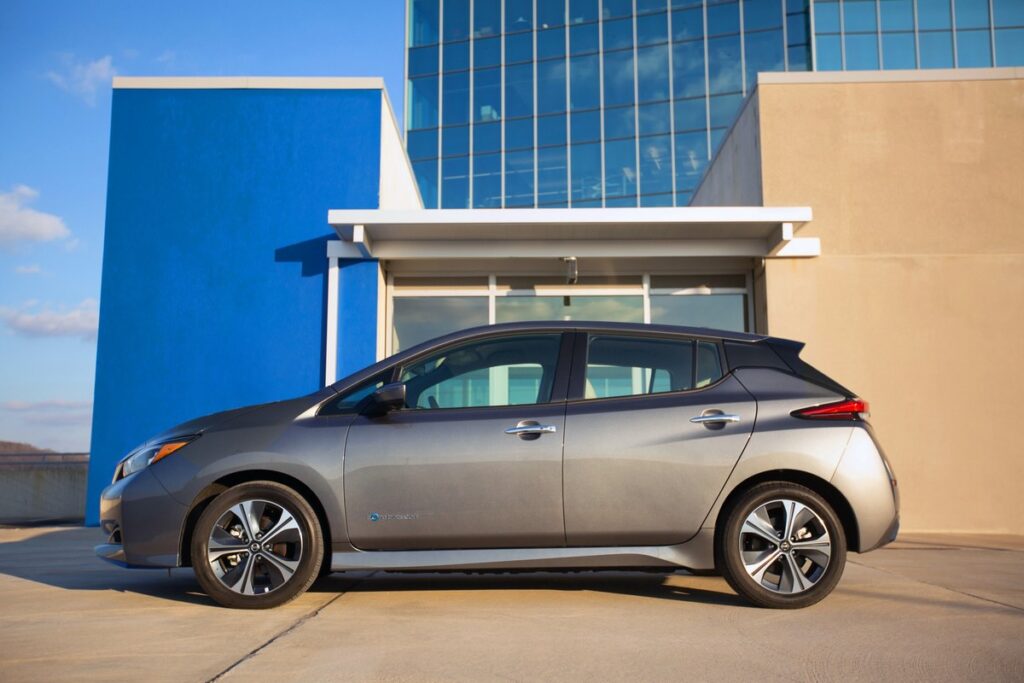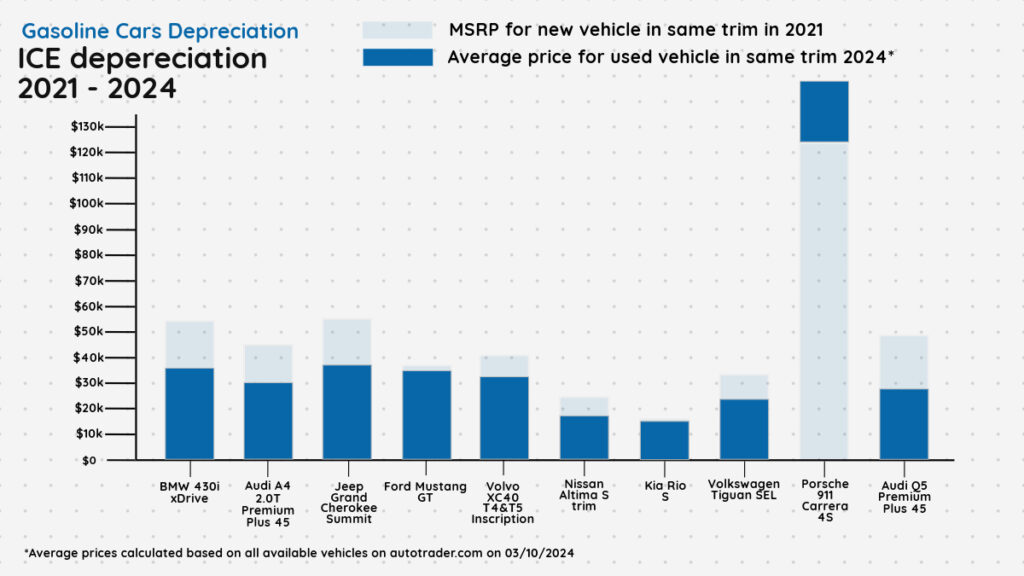Welcome to the high-speed, twisty-turny world of car depreciation. It’s 2024, and the auto industry is as unpredictable as a game of Mario Kart. Remember when all cars were steadily losing their values based mostly on mileage? Well, it’s not the case anymore. With development of new technologies their value can plummet faster than a lead balloon in a vacuum.
Let’s talk depreciation, the sneaky little gremlin that nibbles away at your car’s value. It’s a harsh reality that hits you the moment you drive off the lot. Oh, and don’t even get me started on Tesla trade-in values. It’s like trying to sell a ticket to a concert that’s already over – good luck getting what you paid!
So, what’s up with electric cars?
They’re the cool kids on the block, but like any new tech, they come with quirks. High mileage, age, interior condition – all the usual suspects affect their value. But here’s the kicker: their batteries. As everything they degrade, but besides that manufacturers experiment with putting bigger capacity batteries in new vehicles. Moreover faster charging systems are being developed that cars hardware must support.
And The ICE Cars
Meanwhile, those good ol’ internal combustion engine (ICE) cars are like the reliable old dog who’s been around the block. But here’s the deal: they’re getting old, and people are eyeing those shiny electric pups. Factors like fuel efficiency and environmental impact are making them less appealing, and let’s not forget the cost of maintenance – it’s like feeding a hungry, hungry hippo.
Hybrids? They’re the middle child, trying to get the best of both worlds. They’ve got a foot in each door, but that comes with its own set of problems, but we’ll not dive into these today.
But hey, it’s not all doom and gloom. Some cars are like fine wine – they just get better with age. And let’s face it, the world’s changing. Electric cars might be the new normal soon, with incentives and changing emission standards shaking things up like a snow globe.
So, buckle up, and let’s dive into the riveting world of car depreciation. We’ll explore how electric and ICE cars stack up against each other in this race where the slowest to depreciate wins.
Understanding Car Depreciation: Why Your Car’s Value Drops Faster Than a Teenager’s Phone Battery
Depreciation is like that friend who always borrows money but never pays back. The moment you drive a new car off the lot, its value starts dropping like a lead balloon. By the end of the first year, your shiny new ride could lose even 30% of its value. Ouch, right? It’s like throwing a fistful of cash into a bonfire.
Why does this happen? Well, it’s simple. Cars age faster than a reality TV star’s career. More miles on the clock, more dents and scratches, and suddenly, your car is as appealing as last year’s smartphone model. The average car loses about 40-50% of its value in 5 years according to lendingtree.
What about EVs?

Now, let’s chat about electric cars. They’re the new kids on the block, but they play by the same car depreciation rules. High mileage, old age, cosmetic condition – all these factors pull down an electric car’s resale value. But wait, there’s a plot twist. The technology is progressing faster in these vehicles than in ICE or hybrids, therefore depreciation might be higher. It’s like with computers back in the 00s – you got new tech every year and your 3 years old PC looked like a dinosaur.
And also remember, electric cars have their additional quirks. Batteries are the heart of these vehicles, and if they’re not in tip-top shape, your car’s value plummets. It’s like owning a mansion with a leaky roof. You wouldn’t buy that, would you?
And What’s Up With ICE and Hybrids?
And for the traditionalists, ICE cars are still around, chugging along. But here’s the thing: they’re not the environmental darlings. With rising fuel prices and the world going green, ICE cars are like that one friend who still thinks flip phones are cool.
Hybrids are trying to play both sides. They’re like that person at a party who can’t decide whether to dance or sit. They’ve got electric bits and fuel-powered parts. But this duality can be a double-edged sword when it comes to depreciation.
In the end, understanding depreciation is crucial, whether you’re eyeing a Tesla or a traditional gas guzzler. It’s like knowing the rules of the road before you get behind the wheel. And trust me, in the world of cars, what you don’t know can definitely hurt your wallet.
So, there you have it. Depreciation is the sneaky thief that robs your car of its value, and it doesn’t discriminate – electric, ICE, or hybrid, they all take the hit. But forewarned is forearmed, right? Stay savvy, and maybe you won’t get taken for a ride.
Depreciation of Electric Vehicles: Riding the Lightning of Value Drop
Electric Vehicles are like the new smartphones of the automotive world. They’re cool, high-tech, and everyone wants one, until the next model rolls out. Depreciation hits EVs like a morning after a wild party – inevitable and a bit painful.
First, let’s talk about the star player, Tesla. Tesla trade-in values are like a rollercoaster at an amusement park – exciting and unpredictable. They’re in demand, sure, but they also face the same depreciation challenges as other EVs. Rumors say that a new Tesla can lose even 60% of its value in three years. It’s like splurging on a fancy dinner that turns into leftovers by the weekend. So let’s dive into different electric vehicles brands and models and see if they are ageing like a good wine or dropping in price like stocks during great depression.
The Chosen EV Depreciation Table
| Price | Tesla Model S Long Range | Tesla Model 3 Long Range | Ford Mustang Mach-E GT | Polestar 2 | Volvo XC40 P8 Recharge | Nissan Leaf S Plus | Kia Niro EV EX | Volkswagen ID.4 1st Edition | Porsche Taycan 4S | Audi e-tron Premium Plus |
|---|---|---|---|---|---|---|---|---|---|---|
| US 2021 new car MSRP price | $82,449 | $48,198 | $59,900 | $61,200 | $55,085 | $39,365 | $40,265 | $45,190 | $105,150 | $75,895 |
| US 2024 average resale price | $57,867 | $31,051 | $39,361 | $32,669 | $34,081 | $18,002 | $21,662 | $27,384 | $79,313 | $37,115 |
| Average Mileage | 25,052 | 34,658 | 17,335 | 19,731 | 24,811 | 24,663 | 14,843 | 24,677 | 19,481 | 27,455 |
| Loss in USD | $24,582 | $17,148 | $20,539 | $24,700 | $21,004 | $21,363 | $18,603 | $17,806 | $25,837 | $38,780 |
| Depreciation | 29.81% | 35.58% | 34.29% | 40.36% | 38.13% | 54.27% | 46.20% | 39.40% | 24.57% | 51.10% |
Based on that we can see that EVs really lose lots of their original value during first 3 years. This loss can be even as high as 54.27% for Nissan Leaf.
The Electric Vehicles Values
But why do EVs shed their value like a dog sheds fur in summer? The answer lies in a few key areas: high mileage, age, and condition – the usual suspects. But there’s a unique twist in the tale for EVs: the battery condition. Batteries are the heart and soul of EVs. If they’re not in top form, your car’s value could drop faster than a hot potato.
There’s a silver lining though. EVs are the poster children of the green revolution. With more charging stations than ever and better technology, they’re not just a passing fad. This growing popularity helps cushion the blow of depreciation. Brands like Tesla, thanks to their cult-like following, sometimes defy the typical depreciation trend. A Tesla Model 3, for example, holds around 65% of its value after three years. Not too shabby, right?
But let’s not put on rose-colored glasses just yet. The EV market is still maturing. Government incentives for buying new EVs can sometimes dampen the demand for used ones. It’s like choosing between a brand-new smartphone and a refurbished one – most people go for the shiny new thing.
Ok, so at the moment EVs are dropping their values rather fast, but does it say how should we treat that? After all car is still a tool that improves our living conditions and helps us with doing our job, so we probably shouldn’t expect it to hold its value like grandma’s old china. So now when we more or less know how EVs are losing their value let’s see how it looks for good old gasoline powered vehicles. After all we need to have something to compare to, right?
ICE Car Depreciation: Old Faithfuls Facing a Storm
Internal Combustion Engine (ICE) vehicles are like classic rock albums. They’ve been around forever, and while not everyone’s cup of tea anymore, they have a loyal following. But when it comes to car depreciation, they’re like milk – they usually don’t age well. But how much on average do they really lose? We took several gasoline powered vehicles from different segments and looked a the data in similar way as we did with EVs. Unfortunately it wasn’t possible to use exactly the same trims from same makes for direct comparison. And here is the result.
The Chosen ICE Vehicles Depreciation Table
| Price | BMW 430i xDrive | Audi A4 2.0T Premium Plus 45 | Jeep Grand Cherokee Summit | Ford Mustang GT | Volvo XC40 T4&T5 Inscription | Nissan Altima S trim | Kia Rio S | Volkswagen Tiguan SEL | Porsche 911 Carrera 4S | Audi Q5 Premium Plus 45 |
|---|---|---|---|---|---|---|---|---|---|---|
| US 2021 new car MSRP price | $54,095 | $46,145 | $56,145 | $37,480 | $40,545 | $25,645 | $17,685 | $33,740 | $123,750 | $49,195 |
| US 2024 average resale price | $36,519 | $30,424 | $38,347 | $35,970 | $32,765 | $18,192 | $15,693 | $24,173 | $148,159 | $28,640 |
| Average Mileage | 27,069 | 29,727 | 37,909 | 23,165 | 29,225 | 58,187 | 46,267 | 37,661 | 13,040 | 44,778 |
| Loss in USD | $17,576 | $15,721 | $17,798 | $1,510 | $7,780 | $7,453 | $1,992 | $9,567 | -$8,945 | $20,555 |
| Depreciation | 32.49% | 34.07% | 31.70% | 4.03% | 19.19% | 29.06% | 11.26% | 28.35% | -7.23% | 41.78% |
The Analysis
Now let’s do rough analysis. The winner here actually with appreciation is Porsche 911 Carrera 4S. However we looked a bit closer into this value to check why this is the case. It turns out that you can build Porsche 911 Carrera 4S that costs more than twice as much as MSRP value. And that might be one of the reasons why 911 Carrera 4S price looks like it is “growing” and we shouldn’t treat it as growing, but discard from analysis until we dive deeper into it. Than we have Ford Mustang GT with only 4.03% of depreciation. Here there is no such explanation and it really looks great in keeping its value.
Next we’re going from the most expensive and sporty vehicles to the cheapest one one the list. Kia Rio dropped it’s value only by 11.26%, but let’s be clear – it didn’t have so much to drop anyway. After that things starts moving fast Volvos with 19.19% depreciation don’t look that bad. And then the range of 30-40%, in which we place most of vehicles that we looked into.
So ICE vehicles depreciate a lot, but it seems like they are able to. In the first year alone, they can lose about 20-30% of their value. By year three, we’re talking a 30-40% drop. ICE car depreciation is as inevitable as traffic on a Monday morning commute.
The Reasons of ICE vehicle depreciation
But why the steep dive? For starters, mileage, after all the main reason for buying a car is to commute. And mileage grows everyday. Then there is new tech, after all you don’t want to buy vehicle with less features than new one for the same price, right? Maintenance costs don’t help either. They can be higher than a skyscraper, making ICE vehicles less appealing in the long run.
Then there’s the environmental factor. ICE vehicles are like plastic straws – not exactly friends of Mother Earth. With the world going green, these gas-guzzlers are facing the music. It’s like showing up to a smartphone convention with a pager.
The Analysis: EV vs ICE in the Car Depreciation Derby
So here we are – we’ve done rough analysis of ICE vehicles depreciation and showed the table for EVs. So how do these compare?
The Electric Vehicles

Let’s start with EVs. They’re the cool kids in school and it feels like they are less immune to car depreciation. The lowest depreciation we can see in premium/sporty segment. Porsche Taycan 4S and Tesla Model S Long Range from our comparison dropped in value the least. The numbers are respectively 24.57% and 29.81%. And that would be it when talking about depreciation of EVs below 30%.
Then we have Ford Mustang Mach-e GT and Tesla Model 3 Long Range that holds about 65% of its value after three years. That’s like a new smartphone still worth something after endless software updates. Then we have Volvos, Volkswagen and Polestar – these guys are dropping around 40%. And from this moment it gets really terrible Audi and Nissan are losing more than 50% of their base price over 3 years. If you treat a car like investment, you shouldn’t really buy neither Nissan Leaf nor Audi e-tron.
Traditional ICE Vehicles

Now, ICE vehicles. As we previously analysed, they’re the old guard, dependable but not exactly exciting. They face a moderate car depreciation curve, losing about 30-40% of their value in the same three-year period. It’s like owning a DVD player when everyone’s streaming – reliable but a tad outdated.
So, what’s the takeaway? Why are EVs dropping prices that fast, while outdated ICE vehicles are keeping their values? There are many reasons. As the main we see recent “price war” on EVs market. Manufacturers are dropping prices of new vehicles in crazy pace. And I bet you don’t want to buy used same model of vehicle in higher price than the brand new one, right?
Then there is the tech – 3 years ago we still were producing cars with very limited range – take Nissan Leaf as example, nowadays we have more alternatives with bigger range and faster charging. Then we got into charging – the older the EV the more time you need to spend on fast charger during road trip. New EVs allow you to use 350 kW chargers in full power. With older ones you are only able to use a small piece of its capabilities.
Key Takeaways
And there we are – if you’re looking for a car that holds its value better, you should rather still stick to combustion engines. EVs on the other hand are slowly pushing old ICE vehicles out of the market, but we don’t predict everyone to switching to EVs during this decade.
In conclusion, your choice depends on what you value. Are you chasing the latest tech with a Tesla? Or are you content with the tried-and-true ICE vehicle? Perhaps you prefer the middle ground with a hybrid. Just remember, in the race of car depreciation, every vehicle crosses the finish line – just not at the same speed.
Impact of Depreciation on Buyers and the Secondary Market

Car depreciation doesn’t just affect owners; it’s a major player in the whole automotive ecosystem. When buying a new car, the sword of depreciation hangs over your head. It’s like buying a new phone – you know the value drops the moment you start using it.
For savvy buyers, depreciation is the secret sauce in getting a good deal on the secondary market. Cars that depreciate faster, like many EV vehicles, can be bargains in the used car market. It’s like snagging a designer jacket at a thrift store.
On the flip side, cars with slower depreciation rates, like many ICE vehicles, hold their value. This means higher trade-in values but also higher costs for second-hand buyers. It’s a double-edged sword.
In the used market, car depreciation shapes buyer’s choices. It’s the invisible hand guiding them towards either nearly-new, off-lease luxury cars or towards older, more affordable options. Each choice comes with its own perks and pitfalls.
In a nutshell, understanding depreciation is like having a superpower in the car market. Whether you’re buying new or used, knowing how different cars lose value can save or cost you thousands.
Conclusion
So there you have it, the rollercoaster ride of car depreciation. Whether you’re eyeing a sleek Tesla, a trusty ICE vehicle, or a versatile hybrid, remember that depreciation is an inescapable part of car ownership.
To sum up, ICE vehicles, are leading the pack in holding their value, while electric vehicles often see a steeper drop. But it’s not just about the type of car. Factors like brand popularity, technological advancements, and market trends all play their parts in this intricate dance of depreciation.
Ultimately, whether you’re a first-time buyer, a seasoned trader, or a curious bystander, understanding car depreciation is key to navigating the complex world of automobiles. It’s the difference between a savvy investment and a costly mistake. Drive smart, shop smarter, and let depreciation be your guide, not your downfall.
Dive into other our articles at guides section!

